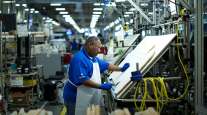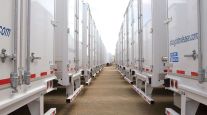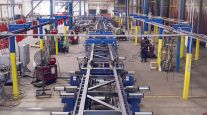Contributing Writer
Trailer OEMs Work to Keep Up With Supply, Labor Demands
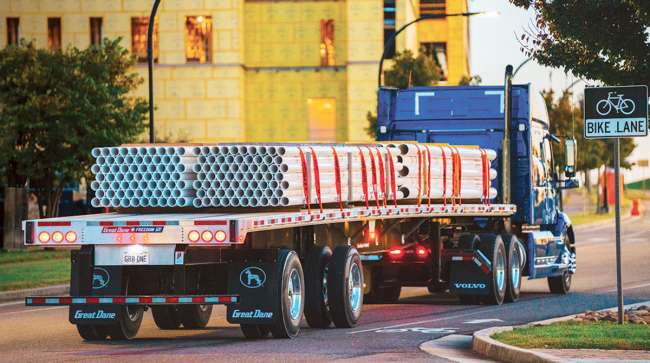
[Stay on top of transportation news: Get TTNews in your inbox.]
Trailer manufacturers are “eating backlog” now that market demand has normalized and supply chain disruptions have abated after the COVID-19 pandemic. But some components are still in short supply, and finding workers continues to be a challenge.
Meanwhile, they’re increasingly employing telematics technology so fleets can better monitor their investments, and they’re looking ahead to a future that will include more electric trucks and autonomous vehicles.
Manufacturers say they are catching up from the pandemic’s challenges. Faviola Gomez, product manager at Wabash, said the supply chain is still recovering from what she called the “unprecedented demand we have had over the past few years.”
Stoughton Trailers’ Dave Giesen, vice president sales, said his company is opening up orders for the first quarter, with 4-5 months’ lead time depending on the build order. In a normal market, it would be 3-4 months.

Giesen
He noted that’s better than it was at the worst of the pandemic in 2021-22, when lead times were more than a year as demand was more than double what the industry could fill.
“It was not a bad thing because if we had built all that demand that was there, we would drop to zero demand now because that’s the roller coaster that happens in the trailer industry,” Giesen said. “There were shortages on almost every major component.”
Eating Backlog
Chris Cooler, vice president of sales and marketing for East Manufacturing, expects production to outpace orders moving into 2024, with falling spot rates, higher interest rates and inflation having softened the trailer market.
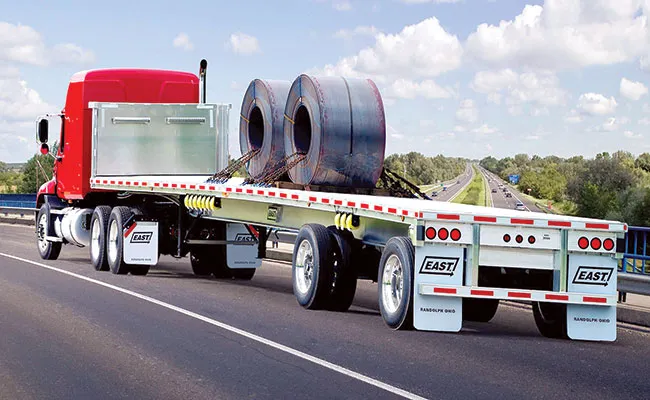
East Manufacturing Corp.
“These market forces have created a condition in manufacturing generally referred to as ‘eating backlog.’ It is likely that order rates will continue to fall into the first portion of 2024. But there is optimism for the long-term market,” he said, referring to expected favorable trends related to interest rates and inflation.

Hammond
Chris Hammond, executive vice president of dealer and international sales with Great Dane, said demand has normalized. The company recently opened up orders for the first quarter of 2024.
“I think everybody’s been eating into the backlog because they haven’t been really turning on the new year yet, and things have been a little sluggish in the freight market, so trucker profitability’s slowed down a little bit,” he said. “So we’re not shocked that it slowed up a bit. We feel like next year’s still going to be a nice year in the trailer business. It’ll be OK in the first half, and we think it’ll start ramping back up in the second half. … Maybe we can get caught up on things because, for two-and-a-half years, we’ve been behind.”
With some components still in tight supply, citing axles, suspensions and doors, Hammond said North American suppliers — not those from overseas — have been the primary issue. “It got better and then it got worse, and then it got better, and I don’t know if I’m in the middle of better or worse yet,” he lightheartedly noted.
Finding Workers
Meanwhile, labor shortages continue to impede manufacturers’ ability to deliver trailers on time. Stoughton’s Giesen said labor availability has improved “but is far from ideal.” Salaries have increased, but laborers have to be willing to work in a factory setup.
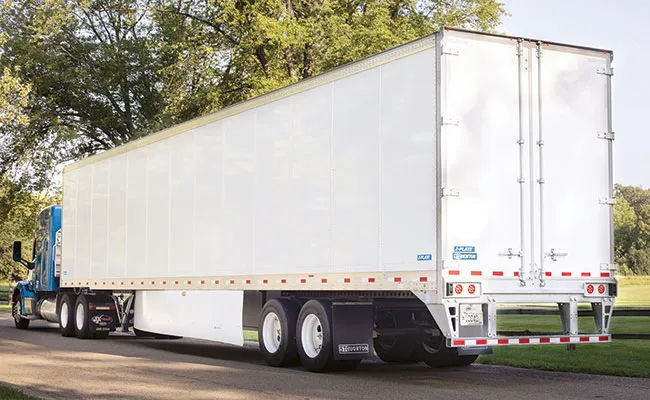
Stoughton Trailers
Great Dane has increased wages but is also looking at robotics and other technology as solutions. Last year, it opened a $50 million central fabrication plant in Indiana. It brought all the welding operations from its nine manufacturing facilities into one automated location.
“We seem to have reached a plateau on hiring which we have partially offset by introducing more factory automation, technology that will continue into the future,” said East’s Cooler. “We have made advances in personnel retention through a variety of incentive programs and employee appreciation events.”
Consumer Concerns
Asked what fleet customers are seeking, Cooler said they have different priorities, but “safety measures, weight savings, longevity of equipment, cargo securement, corrosion prevention, ease of maintenance and increased advances in connectivity through telematics are almost always a matter of discussion.”
Stoughton’s Giesen said fleet customers aren’t asking for too much. “For the most part, they just want the products to provide long life with as few maintenance issues as possible,” he said.

Transport Topics' Seth Clevenger, Michael Freeze and Mike Senatore dissect the new Top 100 list of the largest private carriers, including how fleets are adapting to this softened market. Tune in above or by going to RoadSigns.ttnews.com.
Tom Wiseman, CEO of Fruehauf Inc., said customers are making safety features a top priority. Other customer requests include maintenance and serviceability along with durability and reliability. He expects customers to continue to demand more customized options. Fruehauf last year opened a 125,000-square-foot manufacturing plant in Bowling Green, Ky. The 290-employee plant will assemble dry vans with a capacity of 5,000 units. The plant is Fruehauf’s first U.S.-based location since 1997.
Growing Technology
Telematics are increasingly becoming a part of the trailer industry. Great Dane now includes its Fleetpulse product as a standard offering.
“Pretty much everything we build has some type of telematics system on it,” Hammond said.
In fact, he predicts that “all fleets will be connecting to trailers in the next few years.” Fleets are looking for safety and efficiency. They want to know where the trailer is, how healthy it is, and what’s in the trailer. Cameras are becoming more prevalent. Larger companies have been adopting telematics over the last few years, and now so are fleets of all other sizes.
“No longer will you see thousands of trailers built that do not have connectivity back to the fleets,” he said. “We have seen a dramatic increase in the number of fleets using telematics for trailers. The value in smart trailers is being realized across the industry, and all fleet sizes are now engaged in how to better utilize the data trailers can offer for a safer, more efficient fleet.”

Gomez
Wabash’s Gomez said the growing focus on driver efficiency and increased equipment uptime will drive more sophisticated uses of smart trailers.
“The increased digital footprint of the equipment itself will need to integrate with machine learning and AI to drive innovative customer solutions,” she said. “Additionally, new business approaches, including power-only models and autonomous vehicle growth will force OEMs to innovate their business models as they transform to better meet the needs of a rapidly changing marketplace.”
As increasing amounts of data are shared, the industry is looking to standardize the connections between trucks and trailers. The standard U.S. configuration is a seven-pin J560 electrical cable along with two pneumatic cables used for braking. But many fleets are using a second electrical cable, which is standard in Europe, in at least some applications.
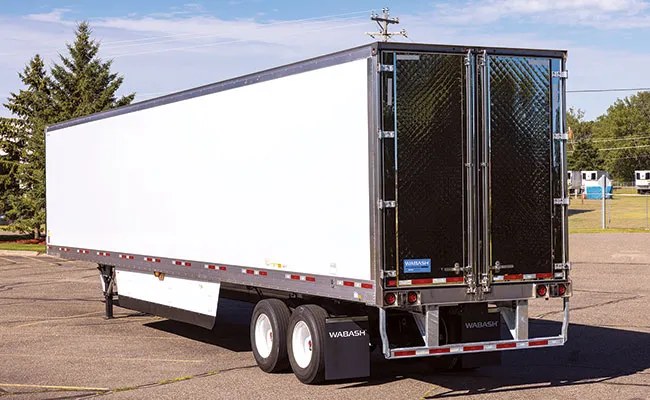
Wabash
On another subject, Hammond said Great Dane is working with fleets on how the trailer and truck body will participate in the evolution of electrification. Great Dane is already building boxes for electric chassis manufacturers. The company earlier this year launched a program evaluating an all-electric refrigeration system in collaboration with Performance Food Group Company, Navistar and Carrier Transicold. It featured the technology at the Advanced Clean Transportation Expo in May.
The company is looking toward the future when Class 8 trailers for the electric market become more commonplace. Trailers with e-axles and batteries could store energy and even create it through regenerative braking to help power and perhaps help propel the truck. If that happens, manufacturers will have to determine how to reduce the weight of other components to make up for the weight of the batteries.
Likewise, Great Dane is also looking to the future of autonomous trucks knowing the trailers will have to be smart and able to talk to the truck and to the dispatcher.
Want more news? Listen to today's daily briefing above or go here for more info
“Fleetpulse was kind of our first foray into telematics,” Hammond said. “We think that’ll help us get to automated vehicles in the future leveraging kind of what we’re learning having our own telematics for trailers.”
Another trend in trailers is the increased use of aerodynamics-friendly components. Hammond said fleets are requesting add-ons like skirts and self-deploying tails.
“We’re seeing it on pretty much the majority of our equipment now [that] gets some type of aerodynamics, when five years ago it was probably half of that,” he said.
Stoughton’s Giesen said skirts offer the biggest return on investment. Manufacturers are making them more durable so they can take the impacts that come with driving.
What’s out are additions like manually operated tails that require drivers to deploy them. Experience has shown that many drivers often don’t do it, and fleets would rather them use that time to get on the road, Hammond said.
Also, manufacturers including Great Dane are galvanizing more of their steel parts, including dolly legs and the rear impact guard, as a standard offering to increase their longevity. Stoughton is using a third-party onsite galvanizer for most steel components. It’s extended the lives of those parts significantly compared to paint, Giesen said.


